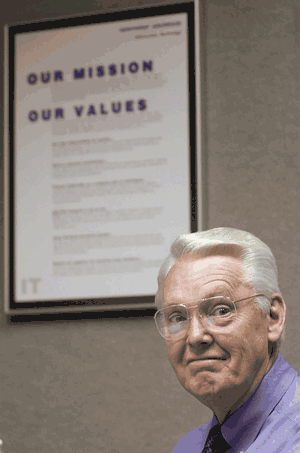Survival Guide: Herb Anderson, corporate vice president for special projects, Northrop Grumman Corp.

Much of Herb Anderson's professional life has been about integration. He built Northrop Corp.'s first standalone information technology unit by pulling together pieces from different company divisions.

Herb Anderson, corporate vice president for special projects, Northrop Grumman Corp.
Much of Herb Anderson's professional life has been about integration. He built Northrop Corp.'s first standalone information technology unit by pulling together pieces from different company divisions.
After the merger with Grumman, he led Northrop Grumman Corp.'s IT business for nearly 10 years as it rose to become a major IT services provider, building large complex systems for government agencies.
He's also led integration efforts at Northrop Grumman IT as it acquired nine companies, growing from about $350 million in 1995 to an expected $5 billion-plus in 2004.
Northrop Grumman has gained a reputation for doing acquisitions right, even snagging a favorable case study by the University of Virginia's Darden School of Business.
Anderson retires Nov. 1 and has already stepped down as corporate vice president and president of Northrop Grumman IT. He spoke with Senior Editor Nick Wakeman about integrating acquisitions and leading a company through explosive growth.
WT: Why has Northrop Grumman been successful at acquisitions?
Anderson: We've always had a process for integration, and we've honed it over time. The process includes every functional area of the company. Another important thing is our attitude. When we bought something, we wanted to put together the best company we possibly could.
The process isn't based on imposing Northrop Grumman's ways on you. We took the best processes from [our organization] and the companies we acquired to create a new company. We always looked at five cultural attributes: program management, speed, taking the best of both, communication and focus on customer.
WT: What is the hardest part of integrating acquisitions?
Anderson: The cultural change for the people and the fear of the unknown. You have to get people to understand you are creating a whole new company. You have to get them looking toward the future and get them committed to it ? not the past and not the present, but where are we going and how do we get there.
From a personal standpoint, one of the most difficult things to do was picking the new senior-level managers. I only have seven presidents, and I had 11 to 15 people vying for those jobs. Some people got left behind. It is not easy telling good people they didn't make it.
WT: How did the unit's growth change your job?
Anderson: When we were $500 million, I knew every single aspect of that business. I knew everybody, I knew everything. At nearly $5 billion, I've had to learn to be much better at delegating. I had to adjust to looking at the financials from a higher level. I couldn't get deeply involved in all the human resources issues. I had to make sure that we had a strategic plan in place and that we communicated that plan.
You don't have any choice but to spend less time on the day-to-day activities and spend a lot more time on your strategic direction and communicating that direction to your people and your customers. I became a cheerleader.
WT: In 1997, the government nixed the acquisition of Northrop Grumman by Lockheed Martin Corp. How did that affect the company?
Anderson: We had bought Logicon and Westinghouse Electronics before the Lockheed merger, so we were re-inventing the company at that time. Then we stopped because we were going to be acquired by Lockheed. When the Lockheed merger did not take place, I think the whole company said, "Uh oh, now what?"
[Company CEO] Kent Kresa came out quickly and said we are going to be a tier-1 company. We are going to go back to reinventing ourselves, and we are going to make this company a success. That was a turning point. Within weeks, we integrated Logicon.
Within six months, we bought two more companies, did the integration right away and said we are going to build this thing. I think it worked out much better for everybody.
Anderson: I feel very good about it all, but I could never have done any of it without so many good people. Our success is directly related to the people we have in this company. They are just outstanding, and I am very proud of them.
WT: On May 1, Jim O'Neill took over your post as corporate vice president and president of Northrop Grumman IT. What advice did you give him?
Anderson: You need to make sure you are looked at as the strategic leader of the sector. Set a strategic direction. Communicate it, keep communicating it and make sure everyone knows what we are trying to do and where we are going.
Online Extra with Herb Anderson
Herb Anderson's five cultural attributes of integrating acquisitions:
1. Project management. This is key. We run our integration like you would any major program. We had a schedule, deadlines and targets, and we stuck to them.
2. Speed. This is the second most important thing. People fear the unknown, so the quicker you get information to them and tell them how the company is going to run and who is going to run it, the better off you are.
We used an 80-20 rule, which means you make 80 percent of the decisions upfront as quickly as you can. It sends a message to your people about how serious you are about getting this done. The other 20 percent we handled as we went along. We called those jump balls.
3. The best of both. This means you take the best processes and best people and pull them together. We did not tolerate from ourselves or the acquired company the notion of "This is they way we used to do it, so that's the way we are going to do it."
4. Communications. I can't say enough about communications. It has to be constant. Every step of the way, you have to let you employees know what you are doing, why you are doing it, what it means to them and what it means to your customers.
An important message we always communicated was that we were forming a new company. You, the acquired company, are now part of that. We want you to be part of that, and we are creating something new.
5. Customer focus. You must tell the customer what you are doing and reassure them that you will continue to give them great service. This process is going to help them.
WT: So how do you do all that?
Anderson: When we were about $1.5 billion, we bought four companies and went to nearly $4 billion in eight months. We had five pieces to integrate: us, Federal Data Corp., Sterling Federal, Litton PRC and Litton TASC.
We brought together all the high-level management of all the acquired companies and of Northrop Grumman and told them, you have a rare opportunity to create a new company that is going to be $4 billion. I told them to go into a room and not come out until they had the top-level organization put together.
We took the functional areas from all the companies and put them on pieces of paper, and they became what we called poker chips. We put them up on a wall and asked how we were going to organize them in a way that would satisfy our customers into the future.
That was the basic message I gave them. Then I left. I told them to have candid conversations without me and bring me a new organization.
Two days later, they did.
It then fell to me, and over the next 30 days, I interviewed all those people plus others. I came up with the leaders of the seven business units and my staff. We announced that right away.
The next step was using the same process to have all levels of management named, and that happened in less than 60 days.
The whole process took less than 120 days.
NEXT STORY: Wisconsin rides enterprise bus to savings
